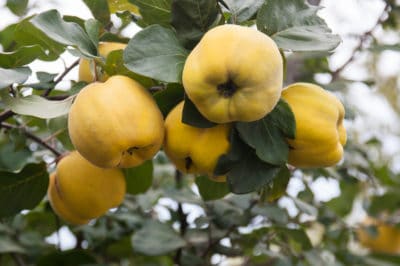What Quince Trees Need
Although quince trees (Cydonia oblonga) have their share of problems, they’ll produce flowers and fruit for 50 or more years with the right growing conditions:
- Climate: Depending on variety, quince trees grow in USDA plan hardiness zones 4 through 9. In order to set buds, they also need winters with at least 300 hours of temperatures between 33° and 45°F (0.55° to 7.2°C).
- Soil: Quince trees fruit well in both acidic and alkaline soils, but they do best in loose, rich consistently moist loam. If your soil is sandy, amend it before planting with drainage-slowing organic compost.
- Sun: The trees flower and fruit best in full sun, but tolerate late-afternoon shade where summers are very hot.
- Water: In the first year after planting, quince trees need slow, deep watering once weekly if in loamy or clay soil, or two times per week in sand. After that, provide at least 1 inch of water (6 gallons or 22.7 liters of water per 10 square feet of soil) each week. Water more during drought.
- Fertilizer: Quince trees benefit from fertilizing with a slow-release, organic 5-2-6 fertilizer enriched with magnesium, sulfur and calcium.
Quince Trees and Pollination
Quince trees pollinate themselves, so planting more than one isn’t required to ensure a crop. That said, cross-pollinated trees typically bear more and bigger fruit than self-pollinated ones.
Expert gardener’s tip: Allow 10 feet between multiple quince trees to accommodate their mature size, allow adequate air circulation and simplify pruning and harvesting.
Planting Quince Trees
To plant your trees:
- Dig holes deep enough to hold your trees’ root balls at the same depth they are in their nursery containers.
- Center a tree in each hole and replace the soil, tamping lightly as you go to eliminate air pockets.
- Water the filled holes thoroughly to settle the soil.
- Cover the planting area with a 3- to 4-inch layer of organic much such as wood chips. Keep it 5 inches way from the trunks, so moisture doesn’t build up around their bark.
Water once more after mulching and you’re done!
